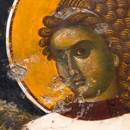
EPHORATE OF ANTIQUITIES OF HERAKLION
Digital Interactive Educational and Promotional Services for the Museum of St. Catherine in Heraklion
THEMATIC SECTIONS

Icon painting in Crete
The adoption of the wooden iconostasis, which replaced the byzantine marble templon, favored the production of icons around the end of the 14th century. The new artistic air brought to Crete by the Constantinopolitan artists that immigrated to Candia and the influence of the Western art, which was favored by the Venetian presence in the island, the trade and the growth of a rich and well educated bourgeoisie, which supported the Fine Arts, helped the emergence of great painters such as Angelos Akotantos, Andreas Rizzo, Theophanes, Michael Damaskenos and Dominikos Theotokopoulos (El Greco) as well as the creation of a specific artistic language in the icon-painting, which was described under the term “Cretan School of Painting”.
More

Wall-paintings
Artistic evolution in Crete ceased abruptly after the Venetian conquer in 1211, since the island became isolated from the artistic centers of the Βyzantine Empire. In the period that followed local artisans remained focus to the archetypes of the past. Under these circumstances, the archaistic and usually provincial character of the Cretan wall-painting of the first period of the Venetian occupation is easily explicable. This style survived until the third decade of the 14th c., when the Cretan painting knew a new revival under the influence of the Palaiologan Renaissance. The gradual penetration of this new tendency and its further evolution, eased by the immigration of Constantinopolitan artisans to Crete due to the ottoman threat, leaded into an accession of the artistic level and formatted the specific character of the artistic vague that was described under the term “Cretan School of Painting”. This high quality painting is encountered in a series of churches, usually related to educated clergymen or wealthy donors, from the end of the 14th and the beginning of the 15th century onwards.
More

Architecture and Sculpture
With the conquest of Crete in 1211, Venice made the Candia (Heraklion), which renamed Candia center of power on the island received the name Regno di Candia (Kingdom of Candia). The importance of the city for the Serene Republic is obvious: it was the first place finish and the last to be dropped after fierce resistance to the Ottomans, after four centuries (1669). The impressive economic, demographic and urban development which followed the Venetian conquest transformed the city from a small provincial Byzantine port in one of the most important commercial centers of the Mediterranean.